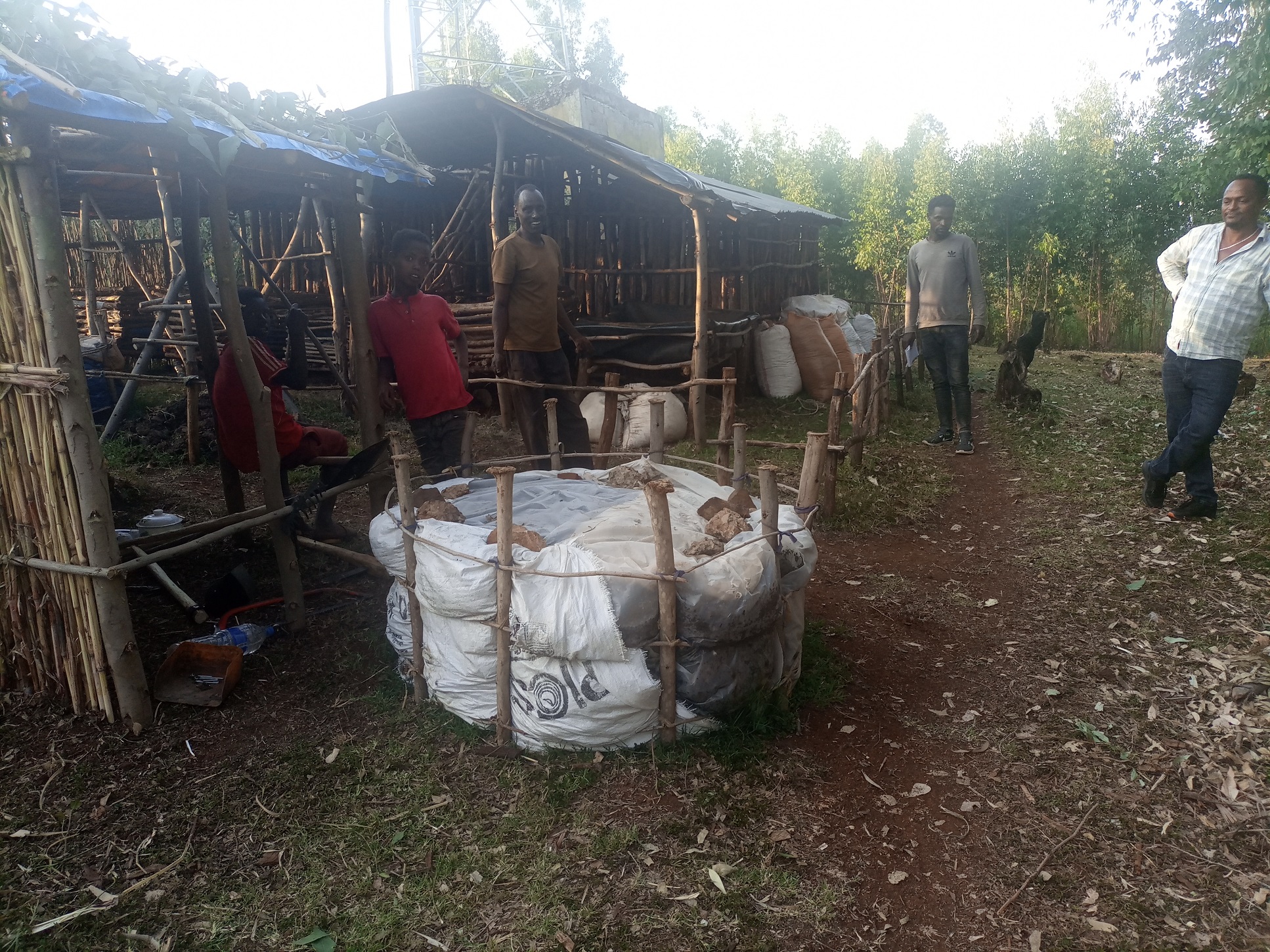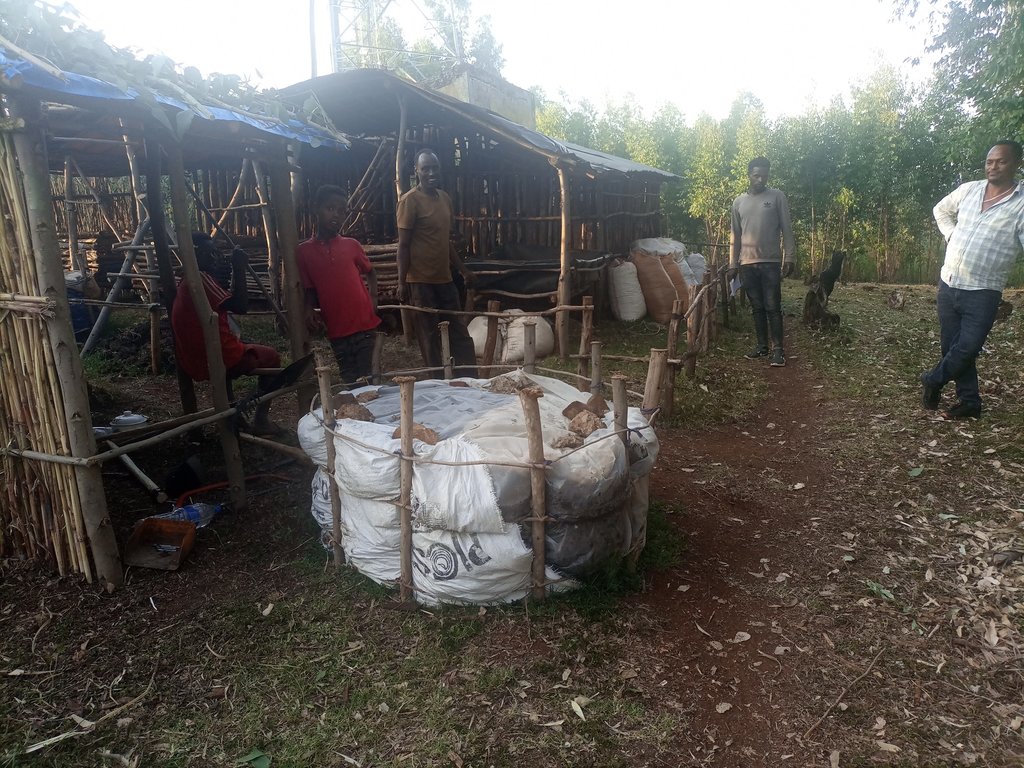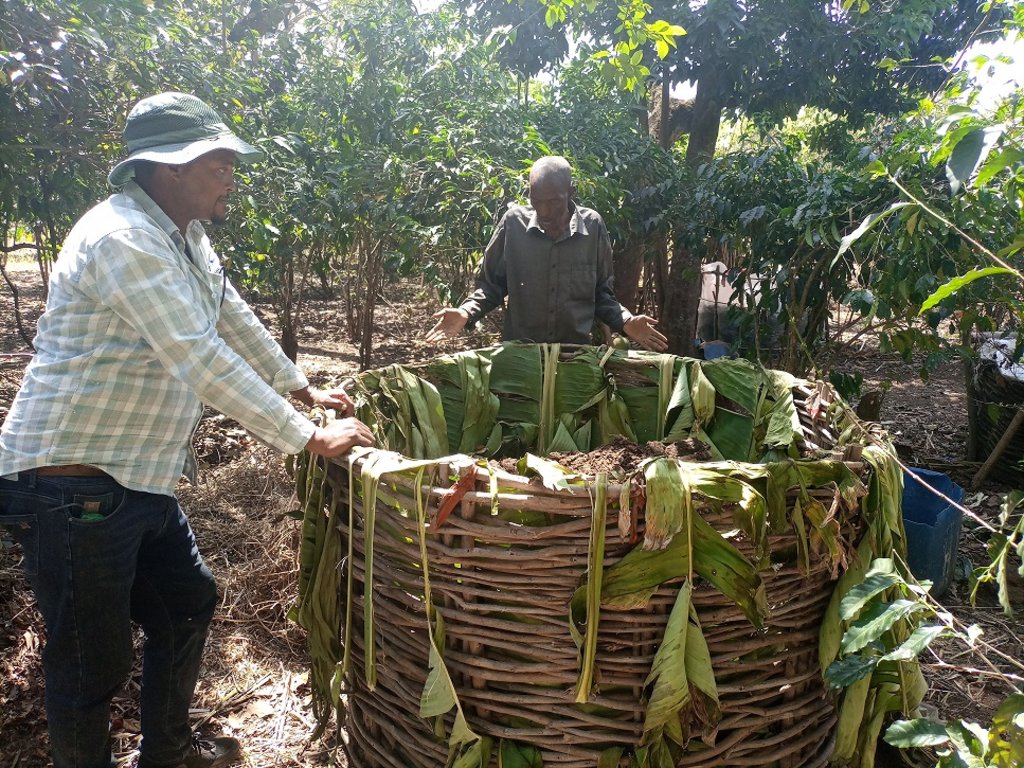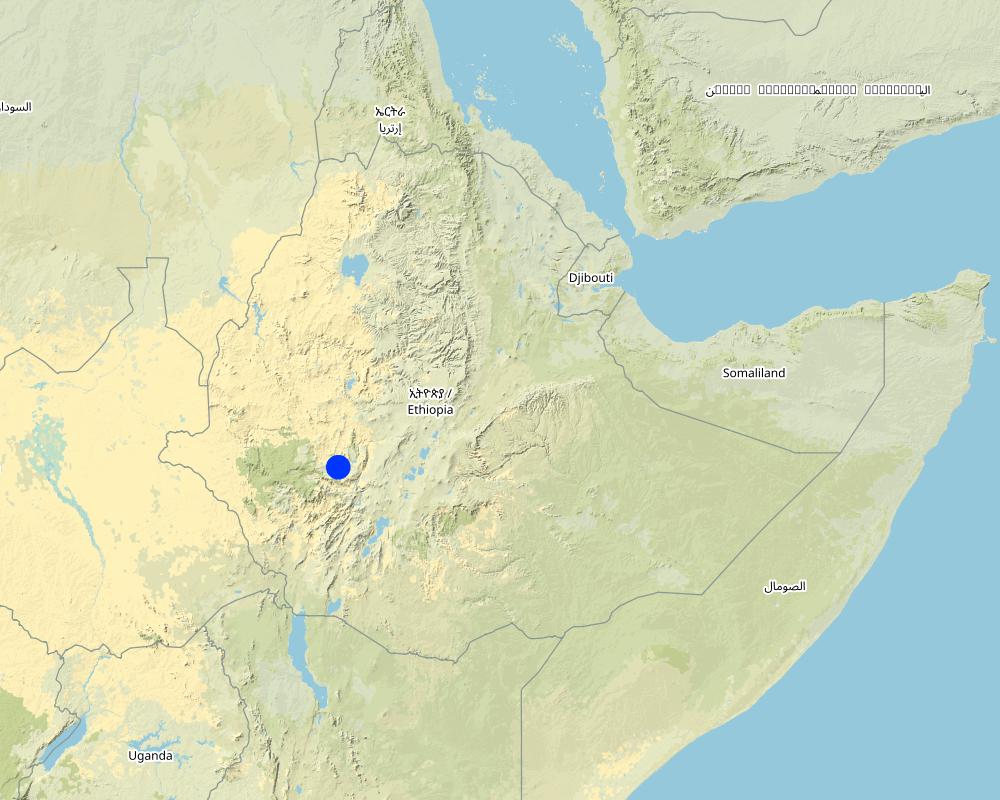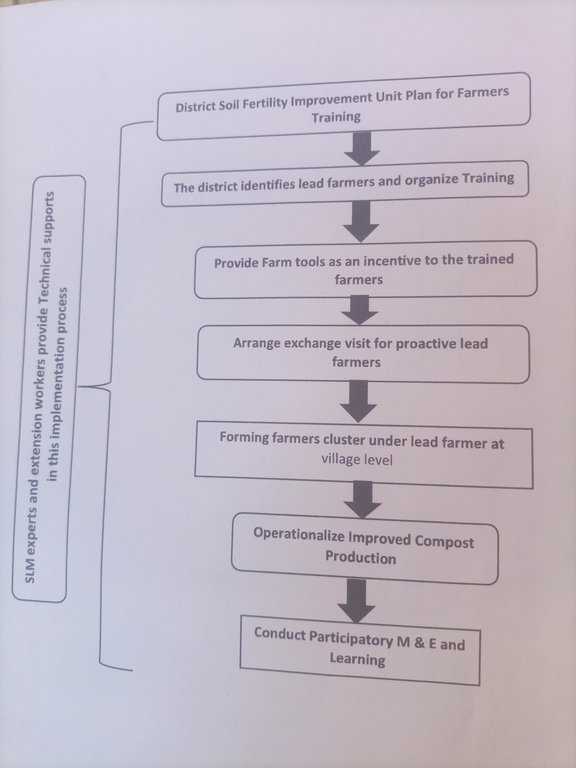Soil Fertility Improvement Cluster [Эфиопия]
- Создание:
- Обновить:
- Составитель: GERBA LETA
- Редакторы: Noel Templer, Julia Doldt, Kidist Yilma
- Рецензенты: William Critchley, Rima Mekdaschi Studer
Foyyainsaa Gabbina Biyyee gareedhan
approaches_6653 - Эфиопия
Просмотреть разделы
Развернуть все Свернуть все1. Общая информация
1.2 Контактные данные специалистов и организаций, участвующих в описании и оценке Подхода
Ответственный (-ые) специалист (-ы)
Специалист по УЗП:
Gebeyehu Bekabil
+251 917 94 10 38
bekabil112@gmail.com
Kersa District Office of Agriculture
Jimma Zone, Oromia
Эфиопия
Название проекта, содействовавшего документированию/оценке Подхода (если применимо)
Soil protection and rehabilitation for food security (ProSo(i)l)Название организации (-ий), содействовавших документированию/оценке Подхода (если применимо)
Alliance Bioversity and International Center for Tropical Agriculture (Alliance Bioversity-CIAT) - Кения1.3 Условия, регламентирующие использование собранных ВОКАТ данных
Когда были собраны данные (на местах)?
09/02/2023
Составитель и ответственный/-ые специалист(-ы) согласны с условиями, регламентирующими использование собранных ВОКАТ данных:
Да
1.4 Ссылка (-и) на Анкету (-ы) по Технологиям УЗП
2. Описание Подхода УЗП
2.1 Краткое описание Подхода
The Soil Fertility Improvement Cluster approach engages five or more farmers living in a village who share skills and labour to prepare and use improved compost as well as to demonstrate it to non-member of the group.
2.2 Подробное описание Подхода
Подробное описание Подхода:
The Soil Fertility Improvement Cluster approach engages five or more farmers living in a village who share skills and labour. Soil fertility improvement interventions in Kersa district of Jimma zone follows this approach. A cluster introduces diverse benefits to the participants including access to a package of inputs, and other benefits and services. Furthermore, it creates awareness and facilitates the adoption and diffusion of various soil fertility improvement technologies such as the preparation and use of improved compost. Kersa district, as one of the scaling out woredas for the Integrated Soil Fertility Management Project (ISFM+), strives to spread appropriate technologies against the growing issues of soil degradation, particularly soil acidity. The approach aims to promote collective learning and action where labour is shared amongst the participating farmers.
The district/Woreda Office of Agriculture’s Soil Fertility Improvement Unit organises annual training for 20 to 40 model farmers from different kebeles, of which five or more are located in the same village and can form a cluster. At the end of the training, the woreda office of agriculture donates a spade or other farm tool as an incentive to engage the participants in the preparation of organic fertilizers such as improved compost and vermicompost. Strict follow-up is carried out, with technical support provided by woreda development actors.
On top of the training organized on improved soil fertility by the woreda office of agriculture experts, a local NGO known as “FC Ethiopia” provides experience exchange visits to other parts of Oromia where improved compost was piloted. This technology involves different activities for the production of improved compost (described in detail as a Technology in the WOCAT database). Farmers' participation in training, exchange visits, collective learning and action, and lessons learning from the actual use of this organic fertilizer vis-à-vis using synthetic fertilizers motivates farmers to uptake and implement the technology. Land users like the simplicity of preparing the compost which takes less time than conventional compost preparation.
2.3 Фотографии, иллюстрирующие Подход
Общие замечания к фотографиям:
The photo shows an improved compost production structure. The farmer demonstrates how different ingredients are mixed and piled in the structure to prepare organic fertilizer that improves the fertility as well as the acidity of the soil.
2.4 Видеоматериалы по применению Подхода
Комментарий, краткое описание:
Video of the approach was not taken.
2.5 Страна/ регион/ место, где применялся Подход
Страна:
Эфиопия
Административная единица (Район/Область):
Oromia, Jimma zone
Более точная привязка места:
Babo kebele
Комментарии:
The production cluster is located near the highway from the district capital, Serbo to Jimma city.
Map
×2.6 Даты начала и окончания реализации Подхода
Год начала реализации:
2022
Комментарии:
The technology is at the pilot stage. So, it is believed to continue by the farmers themselves with technical support and backstopping services from the Woreda Office of Agriculture soil fertility improvement unit staff.
2.7 Тип Подхода
- недавняя местная инициатива/ инновация
2.8 Каковы цели/ задачи Подхода
To learn and prepare improved compost in a group, and restore the increasingly growing problems of soil acidity, the main causes of soil degradation in the area.
2.9 Условия содействующие применению Технологии/ Технологий в рамках Подхода или затрудняющие его
Наличие/ доступность финансовых ресурсов и услуг
- содействуют
It enables land users to easily source some necessary materials such as polyethylene sheet.
Институциональные условия
- содействуют
Cluster formation at the local level enables collective learning and labor sharing among the participant farmers.
Сотрудничество/ координация действий
- содействуют
Simplify group learning and scaling up/out of the technology at a larger scale.
Осведомленность в области УЗП, доступность технической поддержки
- содействуют
Farmers' cluster or group approach improves access to technologies and technical support. Moreover, it improves farmer knowledge about SLM.
Рынки (для приобретения материалов и услуг, продажи продукции) и цены
- содействуют
It enables the farmers to produce surplus organic fertilizer and sell it out to those who require it.
Объем работ, доступность рабочей силы
- содействуют
The availability of family labor simplifies the production and use of improved compost.
- затрудняют
The workload and shortage of family labor have a negative effect on the preparation of improved compost.
3. Участие и распределение ролей заинтересованных сторон
3.1 Заинтересованные стороны, участвующие в реализации Подхода и их роли
- местные землепользователи/ местные сообщества
Farmers
Collective learning and labor sharing.
- эксперты по УЗП/ сельскому хозяйству
Woreda SLM experts and Kebele extension workers.
Technical support and provision of advisory service.
- общественные организации
FC Ethiopia
Arranged experience exchange visit for few farmers.
3.2 Участие местных землепользователей/ местных сообществ на разных стадиях реализации Подхода
| Участие местных землепользователей/ местных сообществ | Перечислите участников и опишите их вовлеченность | |
|---|---|---|
| инициирование/ мотивация | интерактивное | SLM experts and extension workers provide technical support, and a group of farmers jointly learn and implement the technology. |
| планирование | интерактивное | Extension workers engage in the planning process. |
| выполнение | самоорганизация | Farmers are keen to learn and implement the technology via group steering and self-mobilization. |
| мониторинг/ оценка | интерактивное | Woreda SLM experts, extension workers, and farmers engaged in participatory evaluation and learning in a cluster. |
3.3 Схема реализации (если имеется)
3.4 Принятие решений по выбору Технологии/ Технологий УЗП
Укажите, кто принимал решение по выбору применяемой Технологии/ Технологий:
- в основном землепользователи при поддержке специалистов по УЗП
Поясните на чём было основано принятие решений:
- результаты исследований
- личный опыт и мнения (незадокументированные)
4. Техническая поддержка, повышение компетенций и управление знаниями
4.1 Повышение компетенций/ обучение
Проводилось ли обучение землепользователей/ других заинтересованных лиц?
Да
Укажите, кто проходил обучение:
- землепользователи
- местный персонал/консультанты
Если существенно, укажите гендерный и возрастной состав, статус, этническую принадлежность и т.д.
A few women farmers participated in the training among other men counterparts.
Тип обучения:
- в ходе работы
Рассматриваемые темы:
Improving soil fertility using organic fertilizers, acid soil management, crop residue management, crop rotation, etc.
4.2 Консультационные услуги
Есть ли у землепользователей возможность получать консультации?
Да
Укажите, где именно оказываются консультационные услуги:
- на полях землепользователей
- в постоянно функционирующих центрах
Описание/ комментарий:
Advisory service is often given at Farmers Training Center (FTC) and complemented by field visit and provision of on- the- spot technical support and counseling services.
4.3 Институциональная (организационная) поддержка
В ходе реализации Подхода были ли организованы новые институциональные структуры или поддержаны уже существующие?
- да, немного
Укажите уровень, на котором структуры были укреплены или вновь созданы:
- местные
Опишите организацию, функции и ответственность, членство и т.д.
Farmers cluster (soil fertility improvement group). Member farmers jointly learn the technique of producing organic fertilizers, SLM practices, and sharing labor during the time of applying the fertilizer to the farm.
Укажите тип поддержки:
- повышение компетенций/ обучение
4.4 Мониторинг и оценка
Являются ли мониторинг и оценка частью Подхода?
Да
Комментарии:
The monitoring and evaluation are conducted by Woreda SLM experts and seldom with member of the woreda administration and the land users.
Если да, будет ли данный документ использоваться для мониторинга и оценки?
Нет
Комментарии:
As the district/woreda is one of the scaling up woredas for the ISFM+ project, it may/may not be used for the documentation.
4.5 Научные исследования
Были ли научные исследования частью Подхода?
Нет
5. Финансирование и внешняя материальная поддержка
5.1 Годовой бюджет мероприятий по УЗП в рамках Подхода
Если точный годовой бюжет неизвестен, укажите примерный диапазон затрат:
- 2000-10000
Комментарий (например, основные источники финансирования/ ключевые доноры):
Actually, specific data for operational data is not available at the level of the compost production cluster since the training and exchange visits were organized by the woreda office of Agriculture and an NGO. Of course, there are huge labor costs spent by land users to access the feedstock. Also, materials/accessories and farm tools cost for compost production was not precisely accounted for.
5.2 Финансирование и внешняя материальная поддержка, предоставляемая землепользователям
Предоставлялась ли землепользователям финансовая/ материальная поддержка для применения Технологии /Технологий?
Да
Если да, укажите тип(-ы) поддержки, кто ее предоставил и условия предоставления:
Material support during the training such as farm tools (spade/fork) only.
5.3 Субсидии на отдельные затраты (включая оплату труда)
- нет
5.4 Кредитование
Предоставлялись ли в рамках Подхода кредиты на мероприятия УЗП?
Нет
5.5 Другие методы или инструменты стимулирования
Использовались ли другие методы или инструменты стимулирования для продвижения Технологий УЗП?
Да
Если да, поясните:
The woreda SLM/Soil Fertility Improvement unit sometimes purchase surplus organic fertilizer produced by land users to promote them consistently produce and use to restore their soil fertility and address threat of degradation.
6. Анализ влияния и заключительные положения
6.1 Влияние Подхода
Сумел ли Подход расширить возможности местных землепользователей, повысить участие заинтересованных сторон?
- Нет
- Да, немного
- Да, умеренно
- Да, существенно
It brings land users residing in a village together and collectively learn and share labor.
Сумел ли Подход дать возможность принимать решения на основе подтвержденных фактов?
- Нет
- Да, немного
- Да, умеренно
- Да, существенно
It assists in learning from practical application and the remarkable response of the treated soil to the crop.
Сумел ли Подход помочь землепользователям внедрить и поддерживать технологии УЗП?
- Нет
- Да, немного
- Да, умеренно
- Да, существенно
Restoration of the degraded soil owing to the application of improved compost inspired the land users to take up and sustain the technology.
Сумел ли Подход улучшить согласованность действий и повысить рентабельность применения практик УЗП:
- Нет
- Да, немного
- Да, умеренно
- Да, существенно
It brings farmers together by cluster and promotes joint learning and acting.
Сумел ли Подход мобилизовать/ расширить доступ к финансовым ресурсам для применения практик УЗП?
- Нет
- Да, немного
- Да, умеренно
- Да, существенно
Not yet mobilized the resources for the implementation of the SLM.
Сумел ли Подход расширить знания и возможности землепользователей в применении практик УЗП?
- Нет
- Да, немного
- Да, умеренно
- Да, существенно
It improves land users knowledge through joint learning and exchange visit.
Сумел ли Подход расширить знания и возможности других заинтересованных сторон?
- Нет
- Да, немного
- Да, умеренно
- Да, существенно
It allows other stakeholders to learn from the pilot activities.
Сумел ли Подход укрепить сотрудничество между заинтересоваными сторонами/ выстроить механизмы сотрудничества?
- Нет
- Да, немного
- Да, умеренно
- Да, существенно
Сумел ли Подход расширить возможности социально и экономически уязвимых групп?
- Нет
- Да, немного
- Да, умеренно
- Да, существенно
It is believed that economically marginalized groups learn to produce improved compost for sell and generate income.
Сумел ли Подход содействать гендерному равенству и расширить права и возможности женщин и девочек?
- Нет
- Да, немного
- Да, умеренно
- Да, существенно
It increases women's participation in the production process.
Сумел ли Подход стимулировать молодежь/ будущее поколение землепользователей заниматься УЗП?
- Нет
- Да, немного
- Да, умеренно
- Да, существенно
t enables the young generation to build trust in the technology for restoring soil fertility and arresting further degradation.
Сумел ли Подход способствовать улучшению продовольственой безопасности/ качества питания?
- Нет
- Да, немного
- Да, умеренно
- Да, существенно
It increases the quantity and quality of produce by application of organic fertilizer, and compost.
Сумел ли Подход расширить доступ к рынкам?
- Нет
- Да, немного
- Да, умеренно
- Да, существенно
Land users learn to produce surplus compost for sale.
Сумел ли Подход улучшить санитарные условия и доступ к водоснабжению?
- Нет
- Да, немного
- Да, умеренно
- Да, существенно
Conceptually yes, as a long-term impact.
Сумел ли Подход привести к более эффективному использованию электроэнергии/ возобновляемых источников энергии?
- Нет
- Да, немного
- Да, умеренно
- Да, существенно
Сумел ли Подход улучшить способность землепользователей адаптироваться к изменениям климата и смягчать последствия катастрофических погодных явлений?
- Нет
- Да, немного
- Да, умеренно
- Да, существенно
The treated soil holds moisture and allows an extended grain-filling period of the crop and allows it to escape the moisture deficit period.
Сумел ли Подход привести к созданию новых рабочих мест/ к расширению возможностей получения дохода?
- Нет
- Да, немного
- Да, умеренно
- Да, существенно
It creates an opportunity to work on improved compost production during the off-season. Also, surplus production generated income.
6.2 Основные причины, побуждающие землепользователей внедрять УЗП
- рост продуктивности
Using organic fertilizer increases crop production as compared to even using synthetic fertilizers alone.
- рост прибыли (доходности) и рентабельности
Increasing production by default increase profitability.
- снижение деградации земель
The application of compost as organic fertilizer reduces the negative effects of soil acidity and mitigates the overall impacts of degradation.
- престиж, общественное давление/ солидарность
Improving the degraded soil by the application of compost and increasing soil productivity could change the recognition of the land users in the community.
- экологическая сознательность
- приобретение знаний и опыта в области УЗП
Highly increase land users' SLM knowledge and skills via practical application and exposure to evidence-based outcomes.
6.3 Долгосрочная устойчивость мероприятий в рамках Подхода
Могут ли землепользователи самостоятельно (без внешней поддержки) продолжать применение того, что было реализовано в рамках Подхода?
- да
Если да, опишите как:
Farmers enjoy the benefit accrued from the production and use of improved compost. It improves soil fertility and mitigates the effects of soil acidity on the best use of synthetic fertilizers. Also, land users are enjoying the sale of surplus production. At least about 0.5 tons of compost is harvested from a pile which increases the cumulative production of as many heaps as possible.
6.4 Сильные стороны/ преимущества Подхода
| Сильные стороны/ преимущества/ возможности по мнению землепользователей |
|---|
| The approach is based on preliminary training, exchange visit, motivation, and technical support. |
| It promotes mutual learning at the local level and allows other stakeholders to learn from the pilot activities. |
| As it is less labor-demanding and matured shortly compared to conventional compost making, it has a high rate of scaling opportunity. |
| Сильные стороны/ преимущества/ возможности по мнению составителя или других ключевых специалистов |
|---|
| It is an inspiring initiative in the middle of adversity relating to soil degradation so that land users learn from one another, and arrest the ongoing soil degradation. |
| The technology can be easily scaled up as the district is located in high biomass production areas that serve as a source of feedstock to produce more compost as compared to the other part of the country where there is huge competition for multiple uses of crop residue as an ingredient for compost making. |
| Farmer clusters promote collective learning, labor sharing, and transferring knowledge and skills to other land users as peer learning has groundbreaking effects over centralized advisory services associated with conceptual than practical showcasing. |
6.5 Слабые стороны/ недостатки Подхода и пути их преодоления
| Слабые стороны/ недостатки/ риски по мнению землепользователей | Возможные пути их преодоления/снижения? |
|---|---|
| All members of the cluster do not actively participate in collective action. | Promote the active participation of the member of the cluster by strengthening ties and labor-sharing traditions. Also, to engage family labor to cover the gaps. |
| Слабые стороны/ недостатки/ риски по мнению составителя или ответственных специалистов | Возможные пути их преодоления/снижения? |
|---|---|
| Limited stakeholders participation as it is not project-based and is being derived from the motivation and goodwill of Woreda soil fertility improvement unit experts and the model farmers who are members of the cluster. | Create more awareness of the approach. Also, the woreda needs to acknowledge and institutionalize such a beneficial approach that strives to promote collective action against the growing issues of land degradation. |
7. Справочные материалы и ссылки
7.1 Методы сбора/источники информации
- выезды на места, полевые обследования
Two farmers who are member of a farmer cluster.
- опросы землепользователей
one
- опросы специалистов/экспертов по УЗП
Kersa district Soil Fertility Improvement process owner.
7.2 Ссылки на опубликованные материалы
Название, автор, год публикации, ISBN:
CLUSTER FARMING AS NEW APPROACH IN ETHIOPIA. Dejene Mamo. 2019. Conference: Academic presentation
Где опубликовано? Стоимость?
https://www.researchgate.net/publication/347976115_CLUSTER_FARMING_AS_NEW_APPROACH_IN_ETHIOPIA
7.3 Ссылки на материалы, доступные онлайн
Название/ описание:
Collective Action in Rural Communities
Адрес в сети Интернет:
https://resources.uwcc.wisc.edu/Research/AFRI_final_report_full.pdf
Ссылки и модули
Развернуть все Свернуть всеСсылки
Нет ссылок
Модули
Нет модулей


